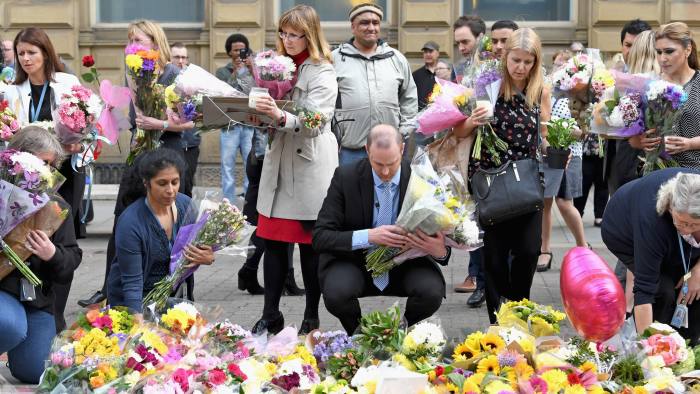Manchester’s tears are in a long tradition of public mourning
an edited version of this column appeared in The Financial Times, 27 May 2017
Only a few days on from Monday night’s atrocity in Manchester and social superiority has set in. A few days removed from the shock of death and no longer are we mourners but each an expert; on Islamist terrorism, on the mental health of young men, on the pop culture of teen girls.
Once we reach the point-scoring stage of any tragedy, visceral grief is no longer fashionable. Tears become a sign of political weakness. On Tuesday evening, thousands gathered in Manchester’s central Albert Square to mourn, to hear music and poetry, and to offer thanks to first responders. The next day, the provocateur Brendan O’Neill was writing in Spiked with contempt for “the hashtags. And the candlelit vigils”, under a standfirst declaring: “We need more than mourning in response to the new barbarism.”
O’Neill’s primary target was not the suicide bomber who murdered 22 at a pop concert — a death toll that included children — but a national response defined by mourning rather than martial spirit. By Thursday, social media was awash with similar sentiment. Alt-right accounts mocked Mancunians for choosing feminine tears over masculine revenge. Most of them appended some call to arms in the name of “British values”.
Yet mass displays of public grief run through the warp and weft of British history. State funerals, accompanied by lachrymose crowds bewailing men they never knew, have played a crucial role in sustaining British — or particularly, English — values at times of national crisis. Research any historical occasion of public grief and you’ll find cynics mocking the mourners, even belittling the dead. These cynics usually turn out to be on the wrong side of history.
The most famous such occasion in England occurred after the death of Sir Philip Sidney in 1586. Sidney, nephew of the powerful Earl of Leicester and a celebrated young poet, died after the battle of Zutphen, fighting a proxy war to repel Catholic Spain from northern Europe. During his funeral at St Paul’s Cathedral, London shut down completely. Crowds followed the coffin; Sidney’s father-in-law, Francis Walsingham, nearly went bankrupt after promising to feed them all.
Were Sidney’s mourners all personally affected by his death? Not in the slightest. But his funeral gave them an opportunity to express a deeper social malaise: the frustration of a nation in severe financial trouble, chaffing under an ageing, heirless queen. Sidney was known as a Protestant hero, and his Anglican funeral also provided a rallying cry for renewed unity against Catholic enemies. But the hysteria at his passing was much mocked. The colourful antiquary, John Aubrey, repeats a rumour that Sidney only succumbed to his wounds after insisting on “carnal knowledge” of his wife immediately after surgery, and tells of scurrilous poetry circulated on the subject.
More recent mockery of public grief has been snobbish rather than scurrilous. Consider the attacks on Hillsborough survivors; the notorious characterisation of Liverpudlians by Boris Johnson as a people who “see themselves whenever possible as victims, and resent their victim status; yet at the same time they wallow in it”. Johnson’s remarks followed the city of Liverpool’s decision to hold a two-minute silence for Ken Bigley, a Liverpudlian contractor beheaded in Iraq by terrorists in 2004. Johnson spared some criticism for the rest of Britain, lamenting “the mawkish sentimentality of a society that has become hooked on grief”. Like Manchester today, Liverpool in 2004 was a northern city with deep, working-class roots, mourning its dead. In both instances, seeing southerners parade a sophisticated detachment is particularly distasteful.
Mass mourning leads only rarely to civil unrest, and more often to civic healing. At Sidney’s funeral, London’s crowds blamed the royal court for military casualties; but the ritual of grief seems to have allowed Elizabeth I’s subjects to let off steam rather than build up resentment. We saw the same phenomenon under a later Queen Elizabeth, after the death of Diana, Princess of Wales 20 years ago. The sea of flowers outside Kensington Palace indicated sorrow, mixed with increasing resentment of a patrician establishment blamed by many for destabilising a sacrificial child-bride. However, the Queen did succumb to calls to lower the Union Flag at Buckingham Palace, to address the nation and approve apublic funeral. The monarchy, as a result, survives.
British grief has never been British weakness. Back in 1586, ambassadors tittered at the funeral for Philip Sidney; Spanish diplomats in Italy exchanged letters mocking the fragility of a nation that would grind to a halt for a public funeral. Such a feminine state, collectively fainting at the thought of a single casualty, could hardly withstand a coming Spanish Armada. Two years later, in November 1588, the Spanish learnt their lesson.







